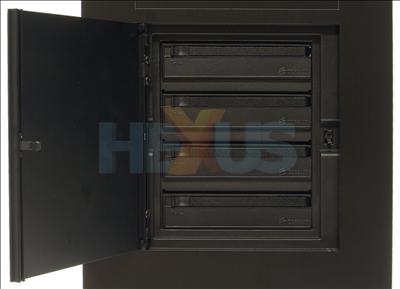Chassis tour - part one
We've already observed the fact that the chassis is big, but seriously, it's very big. If ever there was a full-tower chassis that really towers, this is it.
Corsair's sleek lines result in a minimalistic look that may appeal to some, but it isn't quite taking our fancy. Sure, it's sleek, simple and possibly smart, but it's almost... well, a bit plain, and other than its size, it doesn't look like £200's worth. We'd have liked to have seen a little more flair thrown in, perhaps in the form of more curves, or maybe even a larger back-lit Corsair logo?
If the Mac Pro highlights the style associated with the Apple crowd, the Obsidian Series 800D certainly highlights the lack of panache among PCs:
Corsair's matte-black coating is well finished, but on such a large surface, it quickly begins to look tired. We also found that it can be marked quite easily, so you'll want to keep children and pets at arm's length in order to retain that day-one finish.
At the top of the Obsidian Series 800D's brushed-aluminium faceplate resides a smart flip-down panel, alongside the system power button and activity LED. The push-to-release cover opens nicely to reveal the following selection of I/O ports:
Corsair has opted to equip the chassis with four USB ports, FireWire, and headphone/microphone sockets. Not a bad selection, but a seemingly no-compromise chassis of this stature is surprisingly missing an eSATA connector. What we do like, however, is that the chassis' reset switch is hidden neatly behind the flip-down panel to prevent accidental restarts.
Below the I/O panel reside five 5.25in optical bays. We found ourselves having to detach the chassis' entire front-panel in order to remove the 5.25in drive-bay covers - not exactly what we'd call user friendly, but the optical drives themselves can be installed tool-free.
Farther down, past the five 5.25in optical bays, is another push-to-open door that reveals access to four of the chassis' six hard drive bays. What makes these unique is that they're each hot-swappable and connected to a SATA backplane, allowing for drives to be added/removed without having to venture deeper into the chassis.
Corsair's removable hard drive trays are - as with just about everything in the chassis - finished in black and solidly built. Unfortunately, there are both good and bad points, and we'll cover the good first. Each drive tray supports both 3.5in and 2.5in drives, so the chassis has both your traditional hard-drive and solid-state disks covered. The bad news is that the drive-trays don't offer a tool-free drive installation mechanism. Each drive will need to be screwed into place and then slid into the chassis - that, we reckon, somewhat negates the usefulness of hot-swappable bays.
Not a deal breaker if your drives tend to remain stationary, but something worth considering if you plan on adding/removing drives on a regular basis. Corsair informs us that it's planning on releasing additional hot-swap trays for other drives in the chassis. They're likely to be rolled out through the Corsair Store.
Those who like their doors to open in a certain direction will be happy to hear that the drive cover can be mounted to either side, opening to the left or right.
Over to the back and there's more simple, clear lines and all-black finishing. The Obsidian Series 800D supports a bottom-mounted PSU, and there are plenty of ventilation holes. What we do like are the two buttons in the upper top left and right corners - they allow for the rail-mounted side panels to be detached at the push of a button. Very user friendly, but not awfully secure if for some reason you're planning on lugging this around to a LAN party.















